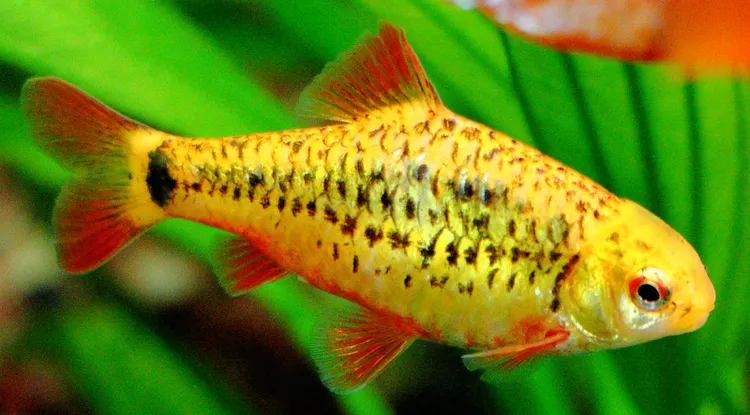
Size
Although the length of an adult gold barb can reach up to 7 centimetres (2.8 in), it typically doesn’t go beyond 3.5 centimetres (1.4 in).
Physical Appearance
The mouth corners of the gold barb are adorned with short barbels that have a rear that slopes sharply. Along the sides of the fish are several dark vertical stripes or blotches. Specimens in good condition may also have red colouring on their fins.
Although this barb’s native colour is green, the gold version of P. semifasciolatus is far more common in the aquarium commerce than the green variety. Virtually every specimen that is currently for sale has been produced in captivity, leading to the emergence of a few additional colour variants, such as an albino version and a tricolor variant.
Habitat
The Red River basin of the Hong River, which flows through Asia from Southwest China to Vietnam, is the natural habitat of the gold barb.
Keeping as Pet

Tank size
It is suggested to purchase fish that are around 2,5 cm (1 in) long. If the tank size allows, you ought to obtain at least 10 different kinds. Usually, this amount is sufficient to create a school with the ideal sex ratio.
A tank with a capacity beginning at 200 litres is preferred. It is preferable to be long rather than wide at that. The problem is that the gold barb is always swimming and is very active. Due to this, the tank’s length should be more than its breadth, although the tank’s height doesn’t really matter (25 cm or 10 inches is sufficient).
Water parameters
The hydrochemical water characteristics that gold barbs can tolerate include temperature ranges of 20 to 27 °C (71.6 to 80.6 °F), hardness ranges of 8 to 20, and pH ranges of 6.5 to 7.5.
Tank Mates
Since gold barbs are calm fish, any fish that isn’t aggressive can be their tank mate. These fishes ought to be little ones like odessa barb, zebra danio, black tetra, boesemani rainbow, cardinal tetra, ember tetra, and neon tetra. Small catfishes like the bristlenose pleco, corydoras julii, panda cory, pygmy cory, hoplo catfish, and otocinclus catfish will do for other fish families.
Diet
These fish are omnivores, which means they will consume both plants and meat. This indicates that there are a plenty of options available when creating a diet. The most crucial thing is to change up their diet. They will remain robust and healthy as a result of receiving a variety of various nutrients from their food.
This typically entails avoiding a diet that is entirely made up of dried foods, including flakes and pellets. During production, they lose much of their nutritious value. Add live or frozen feeds such brine prawns, daphnia, and bloodworms. Give them only what they can comfortably consume in two minutes. Do this a few times every day. By dividing their meal into smaller portions, you can reduce the strain on their digestive tract.
Table





